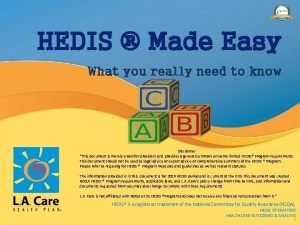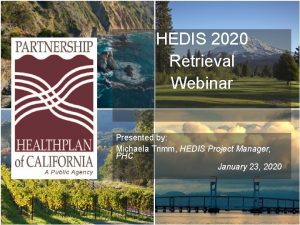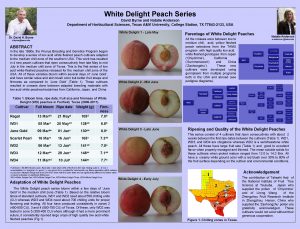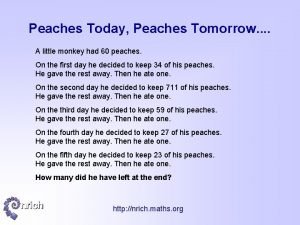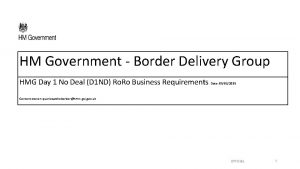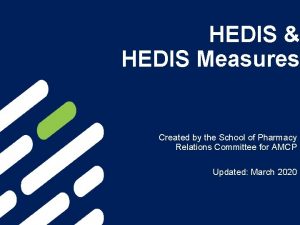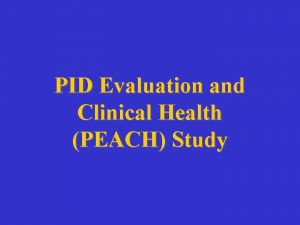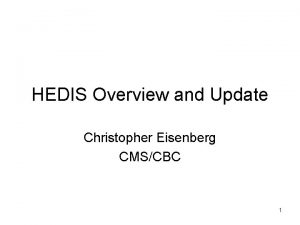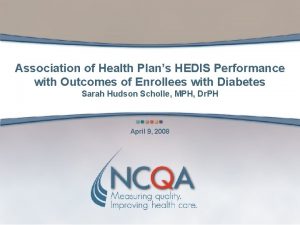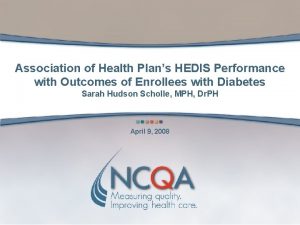HEDIS OVERVIEW AND TIPS Peach State Health Plan














- Slides: 14

HEDIS® OVERVIEW AND TIPS

Peach State Health Plan – At A Glance 400 local employees Serving 400, 000 Georgia families Care Management Organization (CMO) since 2006 Subsidiary of Centene covers: 29 states 2 international markets 11. 4 M managed care members 2

We Are Local and Our Focus Is… Member Concierge Services Our Providers Member Education Member Portal Enrollment & Eligibility Processing Member Rewards Program • Simplified Administrative Procedures • Web Portal and Auth Tools • Supportive Provider Relations Field Teams • Rapid Response Team • Member Connections — Locate Your Patients • Community Based Physician, Rx, & Nurse Teams • Innovative Clinical Programs for Your Patients Member Community Events/Health Fairs Member Connections. Find a Member THINC Appointment Assistance 3

HEDIS® What are HEDIS® Scores Used For? As both State and Federal governments move toward a healthcare industry that is driven by quality, HEDIS rates are becoming more and more important, not only to the health plan, but to the individual provider as well. State purchasers of healthcare use the aggregated HEDIS rates to evaluate the effectiveness of a health insurance company’s ability to demonstrate an improvement in preventive health outreach to its members. Physician-specific scores are being used as evidence of preventive care from primary care practices.

*Well Child Visits in the First 15 Months of Life (W 15) Eight (8) visits should occur by 15 months for EPSDT (HEDIS requires at least 6 visits). To Improve HEDIS Scores: Take advantage of sick visits and sports physicals to perform a well-child visit. **Visits must be 14 days apart (this includes catch-up visits). ** Billing Codes for HEDIS: Diagnosis Codes: Z 00. 00, Z 00. 01, Z 00. 110, Z 00. 111, Z 00. 129, Z 00. 5, Z 00. 8, Z 02. 0, Z 02. 1, Z 02. 2, Z 02. 3, Z 02. 4, Z 02. 5, Z 02. 6, Z 02. 71, Z 02. 79, Z 02. 81, Z 02. 82, Z 02. 83, Z 02. 89, Z 02. 9 Procedure Codes for: 99381, 99382, 99391, 99392 Contact Peach State Health Plan Provider Services at 1 -866 -874 -0633 if you would like to schedule a Peach State Day to increase well visits compliance. *Follow the current Bright Futures Schedule for the Periodicity and Age Specific Components of Well Visits Ages 0 to 21. Updated as of February 2017 American Academy of Pediatrics (AAP) Bright Futures Recommendations for Pediatric Health Care” Periodicity Schedule (copyright 2017) is used for the periodicity schedule for EPSDT visits and services.

*Adolescent Well-Care Visits (AWC) & Well-Child Visits in the Third, Fourth, Fifth and Sixth Years of Life (W 34) HEDIS requires annual visits to be completed before December 31 st of each calendar year. To Improve HEDIS Scores: Take advantage of sick visits and sports physicals to perform a comprehensive well-child visit. **Peach State Health Plan pays for wellcare/well-child visits at each age. ** Billing Codes for HEDIS: Diagnosis Codes: Z 00. 00, Z 00. 01, Z 00. 110, Z 00. 111, Z 00. 129, Z 00. 5, Z 00. 8, Z 02. 0, Z 02. 1, Z 02. 2, Z 02. 3, Z 02. 4, Z 02. 5, Z 02. 6, Z 02. 71, Z 02. 79, Z 02. 81, Z 02. 82, Z 02. 83, Z 02. 89, Z 02. 9 Procedure Codes for: 99382, 99383, 99384, 99385, 99392, 99393, 99394, 99395 Contact Peach State Health Plan Provider Services at 1 -866 -874 -0633 if you would like to schedule a Peach State Day to increase well visits compliance. *Follow the current Bright Futures Schedule for the Periodicity and Age Specific Components of Well Visits Ages 0 to 21. Updated as of February 2017 American Academy of Pediatrics (AAP) Bright Futures Recommendations for Pediatric Health Care” Periodicity Schedule (copyright 2017) is used for the periodicity schedule for EPSDT visits and services.

Childhood Immunization Status: sub measure – Combination 10 (CIS-10) Children must be fully immunized on or before the 2 nd birthday. Note: If the child is 2 years and 1 day old, service(s) will not count towards HEDIS. To Improve HEDIS Scores: Check compliance with immunizations at each well AND sick visit, and administer due/overdue immunizations medically appropriate. Encourage and offer flu shots during the months of September through May. Combination 2 DTa. P IPV MMR Hi. B Hep B VZV PCV Hep A Combination 3 Combination 4 Combination 5 Combination 6 Combination 7 Combination 8 Combination 9 Combination 10 RV Influenza Enter immunizations in GRITS registry as required www. grits. state. ga. us – and enter lead screenings at https: //sendss. state. ga. us.

*Developmental Screening in the First Three Years of Life A Developmental Screening using a STANDARIZED DEVELOPMENTAL SCREENING TOOL must be performed at age appropriate well-child visits: • 9 month visit (1 st year) • 18 month visit (2 nd year) • 30 month visit (3 rd year) To Improve Scores: Ensure a standardized tool is used. **When records are requested, ensure you include the standardized tool used and documented evidence of the screening result or screening score. ** Billing Codes: Providers must bill code 96110 with the EP modifier and the appropriate ICD-10 diagnosis code in order to receive reimbursement for this screening. ICD-10 Diagnosis Code Z 00. 121 or Z 00. 129 Z 02 – Z 02. 89 *The Developmental Screening measure is a Core Set measure, not a HEDIS measure.

Weight Assessment/Counseling for Nutritional and Physical Activity for Children/Adolescents (WCC) ALL Children 3 -17 years old must have documentation of a BMI Percentile, Nutritional Counseling, and Physical Activity Counseling in the Medical Record at least annually. To Improve HEDIS Scores: BMI Percentile, Nutritional Counseling and Physical Activity Counseling should be performed on every child, not just those with high/low BMI values. ** If a child has any visit during the year (sick and/or well), calculation of a BMI percentile and conducting nutritional and physical activity counseling is expected. ** Billing Codes for HEDIS: Nutritional Counseling Physical Activity Counseling Z 71. 3 ICD-10 CM: Z 02. 5 HCPCS: G 0447, S 9451 BMI Percentile: Less than 5 th percentile for age: Z 68. 51 5 th to less than 85 th percentile for age: Z 68. 52 85 th to less than 95 th percentile for age: Z 68. 53 Greater than or equal to 95 th percentile for age: Z 68. 54

Weight Assessment/Counseling for Nutritional and Physical Activity for Children/Adolescents (WCC) CONTINUED What DOES NOT COUNT for Medical Record Documentation: • BMI Percentile: • • • Nutritional Counseling • • • Notation of BMI value only Notation of height and weight only Examples such as "eating a wide variety of foods", or "eats 3 balanced meals per day" do meet criteria as they indicate nutrition behaviors (nutritional value of what the child eats) were discussed. Examples such as "good appetite" or "the child is eating well/not eating well" do not meet criteria because they are an assessment of appetite. Physical Activity Counseling • • Notation of "Cleared for gym class” alone without documentation of a discussion Health education” or “anticipatory guidance” without specific mention of physical activity Developmental milestones as discussion of physical activity, such as “can ride a bike”, “child can crawl, child can jump on one foot" Anticipatory guidance related solely to safety (e. g. , wears helmet or water safety) or to screen time (computer or television) without specific mention of physical activity recommendations

*Follow-Up Care for Children Prescribed ADHD Medication (ADD) Children ages 6– 12 who are newly prescribed an ADHD medication must have at least three follow-up care visits: • One within 30 calendar days of when the first ADHD medication was dispensed (initiation phase) • Two additional visits 9 months after the initiation phase ends To Improve HEDIS® Scores Schedule a two week follow-up to check member and ensure return by 30 days. Schedule 6 weeks, 3 months and 6 months to ensure child has 2 visits in 9 months. Explain the importance of taking medication as prescribed everyday and including weekends. *The intent of the measure is to assess medication impact and side effects and therefore, visits with a counselor does not count. The visit should be with a practitioner with prescribing authority.

Medication Management for People with Asthma – 75% (MMA) Members 5 - 85 years of age who were identified as having persistent asthma and were dispensed appropriate (controller) medication which they remained on for least 75% of the treatment period. To Improve HEDIS® Scores Ensure members who are referred to a specialist for Asthma are keeping appointments. Coordinate with the referred provider on receiving a list of current medications prescribed. Create and maintain an asthma action plan. Stress the importance and positive effects of taking controller medications. Note: This is a measure that tracks the number or prescription fills; not provider appointments.

Comprehensive Diabetes Care (CDC) Members age >18 years old with diabetes (types 1 & 2) must receive: • Hb. A 1 c testing (results should show good control < 9%) • Diabetic eye (retinal) exam • Medical Attention for Nephropathy annually • Blood Pressure (results should show control < 140/90) To Improve HEDIS® Scores Ensure members who are referred to a specialist for Diabetes are keeping appointments. Coordinate with the referred provider on receiving a list of current medications and services. Ensure members are aware of the need to receive diabetic eye exams (Peach State Health Plan covers the exam).

Comprehensive Diabetes Care (CDC) (Continued) Billing Codes for HEDIS Hb. A 1 c Testing and Results: Rapid (in office) Hb. A 1 c 83036 83037 *Results of Hb. A 1 c Testing (CPT -CAT-II) 3044 F: <7. 0% 3045 F: between 7. 0% -9. 0%% 3045 F: >9. 0% Billing Codes for HEDIS Blood Pressure Results: *SYSTOLIC Blood Pressure (CPT-CAT-II) *DIASTOLIC Blood Pressure (CPT-CAT-II) 3074 F: <130 3078 F: <80 3075 F: 130 to 139 3079 F: 80 - 89 3077 F: ≥ 140 3080 F: ≥ 90 *ONLY THE MOST RECENT SCREENING RESULTS DURING THE YEAR COUNTS TOWARDS COMPLIANCE
 Hedis
Hedis What is hedis
What is hedis Kdj hedis
Kdj hedis Hedis
Hedis James and the giant peach vocabulary words
James and the giant peach vocabulary words James and the giant peach vocabulary
James and the giant peach vocabulary James and the giant peach book summary
James and the giant peach book summary James and the giant peach vocabulary
James and the giant peach vocabulary The landlady characters
The landlady characters Testability tips in software testing
Testability tips in software testing White delight four peach
White delight four peach A little monkey had 60 peaches answer
A little monkey had 60 peaches answer Layers of a peach
Layers of a peach Agent ipaffs peach
Agent ipaffs peach Record peach harvest—price lowest in a decade
Record peach harvest—price lowest in a decade
